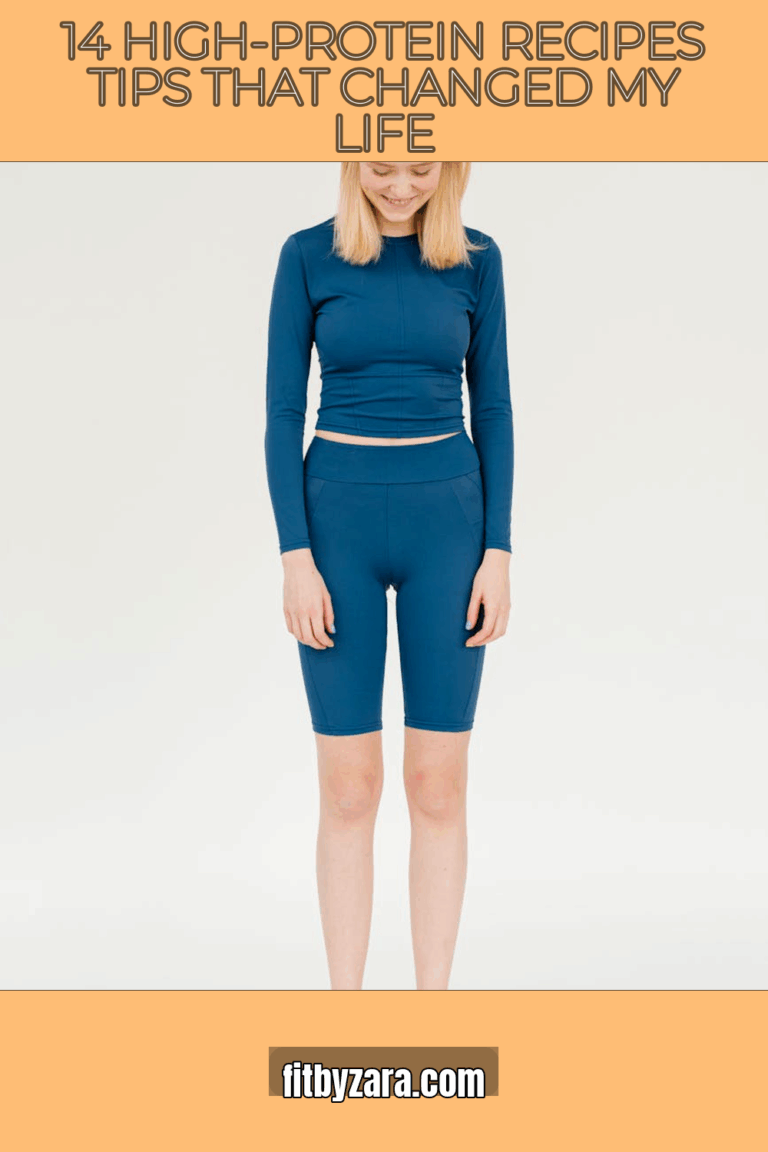Hey, FitFam! If you’ve been following me for a while, you know I’m passionate about nutrition, self-care, and finding balance in our busy lives. For women over 30, maintaining a healthy diet is crucial, especially as our bodies begin to change. High-protein meals can be a game-changer, helping us feel satisfied and energized throughout the day. Today, I’m sharing 14 high-protein recipe tips that have transformed my cooking and my life. Let’s dive in!

Hi, I’m Zara — fitness junkie, wellness nerd, and the voice behind FitByZara.com. This site is all about smart fitness and science-backed wellness tips for real women who want to feel their best.
Why Focus on High-Protein Recipes?
3-Day Energy & Metabolism Reset
Grab the 3-Day Energy & Metabolism Reset — a quick-start guide to feel lighter, more energized, and back in control.

Where should I send your free reset guide?
Before we get into the tips, let’s talk about why high-protein meals are so beneficial for women in their 30s and beyond:
- Satiety: Protein keeps you feeling fuller for longer, reducing unnecessary snacking.
- Muscle Maintenance: Adequate protein intake helps maintain muscle mass, which tends to decline with age.
- Metabolism Boost: Protein has a higher thermic effect, meaning your body burns more calories digesting it compared to fats or carbs.
Mini Checklist: Benefits of High-Protein Meals
- [ ] Keeps you full and satisfied
- [ ] Supports muscle health
- [ ] Aids in weight management
- [ ] Increases energy levels
- [ ] Improves overall nutrient intake
1. Embrace Versatile Proteins
When it comes to high-protein foods, variety is key. Incorporating different sources of protein ensures you get a range of nutrients. Here are some options:
- Animal-based: Chicken, turkey, fish, eggs, Greek yogurt, cottage cheese
- Plant-based: Lentils, chickpeas, quinoa, edamame, tofu, tempeh, nuts, and seeds
“Experimentation is the spice of life! Your taste buds (and body) will thank you.”
2. Start Your Day with Protein
Breakfast is a crucial meal, and starting it with protein can set a positive tone for the day. Here’s how:
- Egg Scramble: Whisk eggs with spinach and feta for a protein-packed start.
- Greek Yogurt Parfait: Layer yogurt with berries and nuts for a delicious, filling breakfast.
Mini Checklist: High-Protein Breakfast Ideas
- [ ] Omelet with veggies
- [ ] Overnight oats with protein powder
- [ ] Smoothie with pea protein
- [ ] Cottage cheese with fruit
3. Use Protein Powders Wisely
Protein powders can be a handy addition to your diet, but it’s important to use them wisely. Here are some ways to incorporate them:
- Smoothies: Add a scoop to your morning smoothie for an easy protein boost.
- Baking: Substitute some flour in your favorite recipes with protein powder.
Pro Tip:
Always check for added sugars and choose quality protein sources.
4. Meal Prep with Protein in Mind
One of the best ways to ensure you’re eating high-protein meals is by meal prepping. Here’s how to get started:
- Cook Proteins in Batches: Grill or bake chicken, roast chickpeas, or prepare lentils for easy use throughout the week.
- Mix and Match: Pair proteins with various carbs and veggies for diverse meals.
Mini Checklist: Meal Prep Essentials
- [ ] Choose a protein source
- [ ] Select complementary sides
- [ ] Store in portioned containers
- [ ] Keep it colorful!
5. Get Creative with Leftovers
Don’t let leftovers go to waste! Here are some ideas for revamping them into high-protein meals:
- Salads: Toss leftover grilled chicken or quinoa into a fresh salad.
- Wraps: Use leftover fish or beans to create a tasty wrap with veggies.
6. Snack Smart
Snacking doesn’t have to mean reaching for chips or sweets. Opt for high-protein snacks instead:
- Nut Butter & Veggies: Dip carrot sticks in almond or peanut butter for a crunchy, satisfying snack.
- Hard-Boiled Eggs: Keep a few on hand for a quick protein fix.
Mini Checklist: High-Protein Snack Ideas
- [ ] Greek yogurt with honey
- [ ] Hummus with whole-grain crackers
- [ ] Jerky (look for low-sugar options)
- [ ] Protein bars (homemade or clean brands)
7. Incorporate Legumes
Legumes are not only high in protein but also fiber. Here’s how to include them:
- Soups and Stews: Add lentils or beans to your favorite soup recipes for a healthy boost.
- Salads: Toss chickpeas or black beans into salads for added texture and protein.
8. Don’t Skip Dinner
Dinner can often be a time when we neglect our protein intake. Here are some high-protein dinner ideas:
- Stir-Fries: Use tofu or chicken with a mix of colorful veggies.
- Baked Fish: Season and bake salmon, which is rich in healthy omega-3 fats.
Mini Checklist: High-Protein Dinner Ideas
- [ ] Quinoa and black bean bowl
- [ ] Turkey and veggie stuffed peppers
- [ ] Chicken curry with chickpeas
9. Experiment with Seasonings
The right seasonings can elevate your high-protein dishes. Here are some favorites:
- Cumin, paprika, and garlic powder: Great for savory dishes.
- Cinnamon and vanilla extract: Perfect for sweet protein snacks.
10. Swap Out Carbs for Protein
When possible, switch traditional carb-heavy foods for high-protein alternatives:
- Zoodles: Use zucchini noodles instead of pasta and top with a protein-rich sauce.
- Cauliflower Rice: Replace regular rice with cauliflower rice for a lower-carb, higher-protein option.
Mini Checklist: Swap Ideas
- [ ] Quinoa instead of rice
- [ ] Chickpea pasta instead of regular pasta
- [ ] Sweet potatoes for regular potatoes
11. Get Saucy
Make your meals exciting with homemade sauces that add flavor and protein. Here are a few ideas:
- Peanut Sauce: Perfect for drizzling over stir-fries or salads.
- Greek Yogurt Dressings: Make creamy salad dressings using Greek yogurt as a base.
12. Include Protein in Every Meal
Aim to include a protein source in every meal. Here’s a quick formula:
- Breakfast: Eggs, yogurt, or protein smoothie
- Lunch: Grilled chicken, tofu, or legumes
- Dinner: Fish, beans, or lean meat
Mini Checklist: Protein at Every Meal
- [ ] Breakfast: (Choose 1)
- [ ] Lunch: (Choose 1)
- [ ] Dinner: (Choose 1)
13. Focus on Whole Foods
Whenever possible, choose whole, unprocessed foods. They often have more nutrients and better protein quality. Here’s a quick list of whole food protein sources:
- Nuts and seeds
- Whole grains
- Organic dairy products
- Fresh meats
14. Listen to Your Body
Lastly, always listen to your body. Everyone’s protein needs differ, so pay attention to how you feel after meals. Adjust your protein intake according to your energy levels, workouts, and overall well-being.
Wrap-Up
Making high-protein meals a part of your daily routine doesn’t have to be complicated or overwhelming. With these 14 tips, you can infuse your meals with protein, nourish your body, and feel your best. Remember, cooking should be fun and fulfilling—so enjoy the process!
Are you ready to give these tips a try? Share your favorite high-protein recipes in the comments below!
Your Turn!
- What’s your go-to high-protein recipe?
- Do you have any other tips to share?
Stay fabulous and protein-rich, beauties!
XOXO, Zara
HepatoBurn: Gentle Support for Steadier Days
When you’re stacking real habits—protein-forward meals, steps, and 7–9 hours of sleep—HepatoBurn is a simple add-on that supports the system behind energy, appetite, and metabolic rhythm.
Why Women 30+ Use It
- Pairs with an already-solid routine—no jitters, no crash.
- Easy to remember: 2 capsules with meals.
- Plays well with protein, walking, and strength training.
How to Use
- Timing: Breakfast & lunch are easy wins.
- Consistency: Use daily for a fair assessment.
- Stacks: Protein-first plates, post-meal walks, lights-down wind-down.
What It Isn’t
- Not a stimulant and not a magic fix.
- Best used alongside habits you’ll actually keep.
- Educational only—talk to your provider before new supplements.
Important: Educational only, not medical advice. Supplements don’t diagnose, treat, cure, or prevent diseases. Talk to your provider before changes to diet, exercise, or supplements.






















